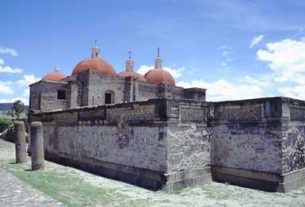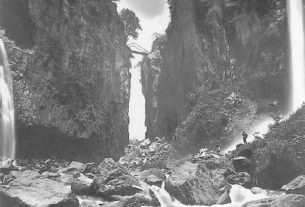I have been receiving a number of letters from people who have an interest in pre-Columbian Mexico and therefore this article will be mostly about my explorations in the vicinity of Tlaxco. Tlaxco is a small town in the small state of Tlaxcala where I live.
It is stated that man has inhabited Tlaxcala for the last 7,000 years. Around 200 BC the Olmec, the mother culture of Mexico, were present in Tlaxcala. Although they never developed a culture identified as the Tlaxcala culture, the area was either influenced by, or dominated by, Teotihuacan and the Toltec. As well, there are Mayan type murals in the ruins of Cacaxla. The various cultures of Mexico built on the progress of their predecessors, as well as the advances of other cultures that they were in contact with. When the “Aztecs” entered the Valley of Mexico, they were considered uncultured barbarians from the North. However, they had the ability to learn, and the energy to build upon what they absorbed. For at least 1500 years before the conquest, the various empires had extended their reach and influence far from the center of their cultures, not only learning from others, but also extending their own cultural influences.
In 1986, I began roaming the hills, searching for artifacts, and learning about the ancient natives of this land. I even wrote small booklets in order to put the things I did learn in some sort of order. I am not an archaeologist, nor do I have any formal education in the field. What I enjoy most is just finding things and trying to put them in some perspective.
For instance. From the street in front of my office, you can see a hill at a distance of about two miles. It even looks like a pyramid. It was something that had to be investigated, after having looked at it for years. Near the bottom of the hill – a portion that had been cultivated and grazed – there had been what you might call, normal erosion. There was an abundance of pottery shards and pieces of worked obsidian. Some were nice enough to put in my humble collection, such as an obsidian earplug, a very small obsidian point of a dart, and a stamp type seal with a geometric design. Farther up the hillside was mostly boulders and nopals and brush. There was also an opening, which appeared to be a cave that had silted in. It is near the small village of La Cueva (The Cave).
The top of the hill is pretty flat, with a pile of boulders more or less in the center. I found pottery shards, but finer and more intricate than down below. It is reasonable to assume that the rocks were the remains of a temple and the pottery shards were either fragments of offerings, or belongings of the priestly cast. While there, I noticed that a flower moved as though the wind was blowing. It was in an indentation in the ground, and there was no breeze. On further investigation, I could feel a breeze flowing from inside the ground. Weeks later I returned with a few friends and we dug an opening into a chamber, which we entered. Having no light, further investigation was put off for several months, untill Chris and his family came down from Texas for a visit. This time we took several flashlights.
The chamber was about 20 feet by 15 feet. The walls and ceiling were of clay, though over the of years bits and pieces had fallen off and lay on the floor as debris. A decision was made to start removing debris at one spot and see if there was a floor. We dug down maybe three feet and found charred wood and bits of small bones, but no floor. That was enough for the day, and I have not been back. It may have had a ceiling and walls of firm clay or other material, which over hundreds of wet seasons, fell as debris to the floor. There may have been an interior passageway. I will probably never know. My assumption is that there was an agricultural village at the base of the hill that tilled the surrounding flat lands, and the village was prosperous enough to have its own temple. Was it an old site? ….over a thousand years? I found nothing to indicate that it was. It was probably just a reasonably prosperous village until someone grabbed their land.
When I first came to Tlaxco, some 14 years ago, I became interested in a very eroded hillside above El Templo de Lourdres, on the outskirts of town. The lower portion of the hillside is practically devoid of vegetation, except for an occasional nopal or small gnarled tree perched on a truncated cone formed by the erosion. Also, crevices or gullies, maybe 25 feet deep, had been formed by run-off, and in places above, you can jump across them. The hard clay surface is littered with pottery shards and pieces of worked obsidian, that have been freed from the levels of soil by erosion, and deposited in a historic jumble, together. I wondered how many centuries it had taken for erosion to wash away the layers of soil which may have existed above the truncated cones, down to the bottom of the cones, and to form the deep crevices. Had it been that long since the site was occupied?
On top of one of the truncated cones, under a nopal, I found a small clay head with zoomorphic features, which had probably adorned a vessel of some sort. I assume, from the form of art, that the little head was over l,000 years old. I also found a larger head, with a Toltec type headdress and other typical Toltec characteristics. The Toltecs reached their zenith around the time of the demise of the Teotihuacan empire (150 BC to 750 AD). The founders of the Aztec Empire would enter the Valley of Mexico some 500 years later.
Another interesting locale I have visited many times is about a five-minute drive from here, near the village of Xalostoc where the blacktop road runs between two hills. It is between the remains of a hacienda in Xalostoc and a working hacienda on the other side. On the hill on the right side of the road there is an abundance of pottery shards and obsidian. The most interesting thing I found was the clay bust of a French soldier, with sharp detail of the dress uniform. I haven’t figured that one out yet. I assume the site was occupied during the time of Maximiliano.
Across the road on the left is a baranca, which one can cross on a massive log. Beyond that is a copse of huge Eucalyptus trees, about three feet in diameter and very tall. I have spent many, many hours exploring this area. It is also eroded but there are patches of ground above the erosion level where you might find fragments of pottery protruding. If you take a knife or screwdriver you can gently remove the item, and if you dig further into the soil who knows what you will find. Once, while scouring the hillside I picked up a little item, which appeared to be the foot of a vessel. There was nothing special about it except I liked its little rounded shape. I went home with my pockets full of nondescript items and my wife offered to help me clean them. She called from the kitchen, “Charlie, I don’t think this is a foot of an “olla”. It turned out to be a stamp seal. The design was that of a dancing monkey with a somewhat comic head of a bird. I think it represents the wind god, Ehecatl.
Another piece, which I almost discarded, was the mid-section of what looked like a gingerbread man, except that it appeared to be feminine. Later, on a visit to the museum in the city of Tlaxcala, I saw almost identical figures. In talking to an archaeologist who was working on a project at the museum, she informed me that they came from the Cacaxla site, and they referred to them as the cookie men.
About 20 or 30 minutes southeast of here are the remains of what appears to have been a small ceremonial center. There are five or six mounds, the largest being 50 or 60 feet long, maybe 25 feet wide, and 10 or 15 high. I once sketched the site, but having moved my office, the notes are probably stored in boxes. There are remnants of retaining walls and also walls of structures, which can be seen at ground level. The walls are of stone with a heavy layer of stucco. I found an outcropping of floor which was apparently covered with the same type of stucco as the walls.
It appears that there has never been an effort to restore the site. However, apparently someone has dug into what seems to have been a tomb. I was told that people had been allowed to dig, for a nominal fee, which really isn’t any way to treat national treasures, but that’s Mexico.
In the nearby town I was shown a stone figurine, about 14 inches tall, of an “owl”. Someone had painted it pink to make it prettier. I think it was a representation of the rain god, Tlaloc. It was assumed to be an owl because of its large eyes.
There is one other site about five 10 minutes from here, near El Penon. I found this site about 14 years ago. I had almost forgotten it, perhaps because I had spent two frustrating days trying to piece together a million fragments of a vase, with Crazy Glue. The results were worth the trouble. It was a nice vase, about 14 inches tall. Fortunately I took a picture of it before it finally fell apart. At the same diggings I dug out a small clay face with an elaborate hairdo, as well as the jawbone of a man. The face also showed facial scarification. It could have been from the Teotihuacan or Aztec era. In a nearby field I discovered a bird’s head formed of volcanic rock. It was about eight inches long.. Apparently it had just been thrown aside when clearing the field of stones.
I have made a number of assumptions in my explorations of the area around Tlaxco. Not being a center of any great empire, it never accumulated the wealth as did other areas. The possibility of finding anything spectacular is very small. The value of the findings is that one can gain an insight into how the average person, in an agrarian economy, lived. And after all, that is the largest part of the big picture.



